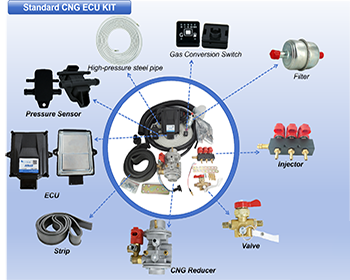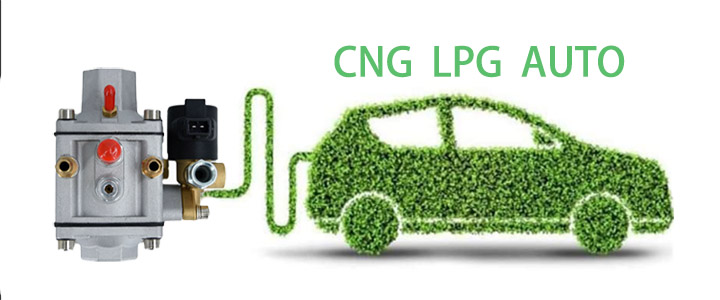Have you grasped the maintenance tips for converting from CNG car
Nowadays, the cost of maintaining a car is higher than buying a car, especially with the current daily rising oil prices, leaving many car owners at a loss for words. Natural gas vehicles, as a new type of energy vehicle, have been favored by consumers since their launch, and the conversion of cars to natural gas has also become popular. At the same time, the maintenance issues and usage precautions after converting to natural gas have also become a topic of concern for many car owners. After converting to natural gas, it is recommended to visit a professional car modification factory for inspection and maintenance every quarter, and daily maintenance should include the following points:
1. Before starting the car every day, check whether the coolant in the water tank and engine oil are sufficient according to the requirements of the car manufacturer's maintenance manual, to avoid potential safety hazards such as high engine temperature;
2. Place a bottle of laundry detergent or dishwashing liquid (as long as it can foam) in the trunk. Regularly apply some foam water to the connections, such as the gas valve, pressure gauge, cylinder valve, and check for any air leaks;
3. When parking the vehicle at night, turn off the lights and check whether there is any leakage in the high-voltage wire. Check the spark plug at the modification factory every quarter to see if there is any breakdown or air leakage, and whether the electrode is severely worn. It is best to ensure that a new spark plug is replaced after the vehicle has traveled 20,000-30,000 kilometers, and a new cylinder line is replaced after 50,000 kilometers to ensure good ignition performance;
4. Regular inspections of the air intake system are essential, as maintaining its cleanliness is crucial. Due to varying dust levels in different regions, the maintenance schedule for the air filter varies. However, it is advisable to ensure weekly purging and annual replacement during seasonal changes. After replacing the air filter, it is necessary to have a professional at a modification shop adjust the mixture ratio of air and natural gas;
5. It is advisable to install a cylinder shield on the exterior of the vehicle cylinder or use rubber to separate it from the debris in the trunk to prevent wear or damage from foreign objects, which could pose a safety hazard.

Key points for inspection of vehicles converted from gasoline to natural gas:
1. Ignition system
Spark plugs should not be used for too long. It is best to ensure that a pair of spark plugs is replaced after 20,000 to 30,000 kilometers, and the cylinder line should be replaced after 50,000 kilometers to ensure good ignition performance.
2. Air intake system
To achieve good economic performance for natural gas vehicles, in addition to a good ignition system, the cleanliness of the air intake system is very important. Due to the different dust content in the air in different regions, the maintenance cycle of the air filter element is also different. Generally, the air filter element should be purged once a week and replaced once every quarter, which can ensure good economic performance for natural gas vehicles.
3. Heating system
This is mainly due to the fact that during winter, when the temperature is too low, the rubber components inside the pressure relief device become stiff, resulting in abnormal operation and preventing the vehicle from functioning properly, leading to a high failure rate. Since most taxis have not had their engine waterways cleaned, the heating of the natural gas pressure relief device is insufficient. If the vehicle's engine waterways have not been cleaned for a long time, it is best to clean them first, and use the pressure reducer after it has heated up. Additionally, even in summer, vehicles should use antifreeze to prevent excessive scale buildup.
4. Inspection of the gas circuit system
After the natural gas device is installed on your vehicle, it is important for you to regularly check for leaks, as it is also a part of your vehicle.

Precautions for using a car after converting from gasoline to natural gas:
1. When entering a gas station to refuel, ensure that there are no passengers in the vehicle, turn off the engine, and switch off all electrical appliances. During the refueling process, stay at least 3 meters away from the gas nozzle and the installation position of the vehicle's gas cylinder to avoid accidents and ensure safety.
2. If you smell a foul odor in the cab, do not start the vehicle. If you are driving, immediately switch to fuel mode and park in a safe area for inspection.
3. When driving a gas-powered vehicle, try to avoid driving in neutral. Neutraling not only damages the engine and transmission, but also severely damages the ignition system, shortens the lifespan of spark plugs and ignition modules, and increases fuel consumption;
4. If your car suddenly experiences a lack of acceleration, jerky acceleration, or backfire, please promptly visit a professional gas vehicle modification factory for inspection and repair. It is highly likely that there is a problem with the ignition system;
5. The engine coolant (antifreeze) must be completely replaced every 50,000 kilometers. It is essential to choose a reputable brand to avoid counterfeit and inferior products, which could cause engine damage due to high temperatures and potentially harm the vehicle;
6. Engine lubricating oil (engine oil) should be replaced at least once every 10,000 kilometers. Choose a well-known brand with a grade of SL or higher, and avoid counterfeit and inferior products. Because the combustion temperature of natural gas is about 400 degrees higher than that of gasoline, adding inferior engine oil will lose its lubricating properties and accelerate the wear of engine components. By following the above guidelines, there should be no problems. If natural gas vehicles are well maintained, they can ensure good economic performance of natural gas.
Refer to£ºhttps://www.atbs.com/post/5-things-you-need-to-know-before-switching-to-cng
The pictures and articles are from the internet. If there is any infringement, please contact us to delete them.
Popular articles
-

How the CNG Automotive S
Compressed natural gas (CNG) automotive systems
-

Advantages Of CNG Gas V
Compressed natural gas vehicles are vehicles th
-

What Is CNG Pressure Red
The pressure reducer of natural gas vehicle is
-

Advantages And Principle
LPG and CNG are two mainstream alternati
-

Reasons For High Gas Con
1. Original vehicle condition A. The tec
-

How To Improve The Power
1. Install ignition advance angle What i
-

Differences Between Sing
Characteristics of Gas Single Point Device
-

How The CNG Gas Vehicle
If you want to know ¨C how does the CNG conversi






Latest comments
0piece comment
no comments, welcome to comment¡£